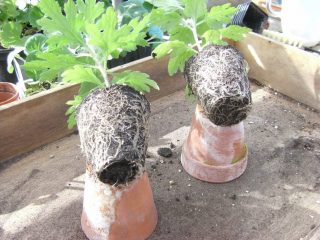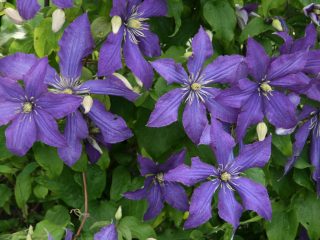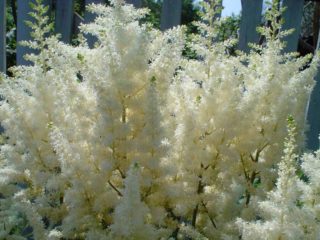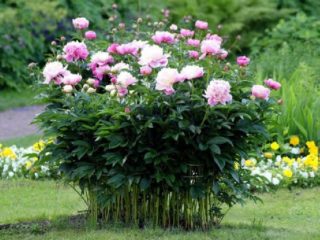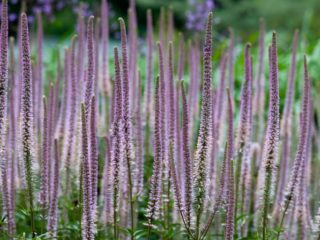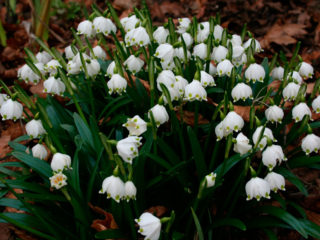Content
Saranka is a flower crop belonging to the Liliaceae family. Over the course of several centuries, the heat-loving plant has fully adapted to the cold climate, due to which its distribution area has expanded significantly. Today, the wild lily saranka is listed in the Red Book.
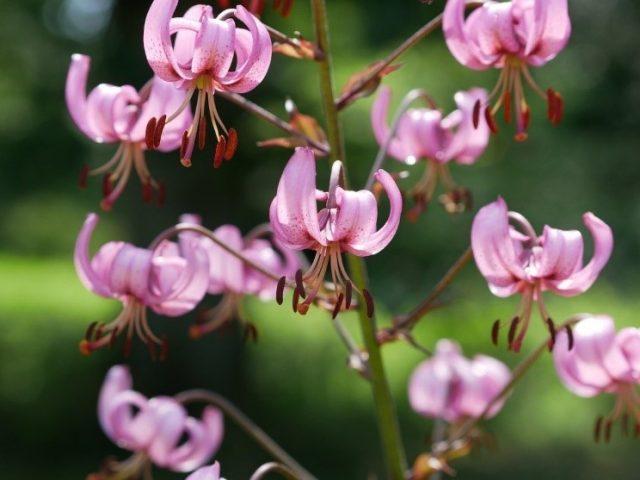
The flowers of saranka collected in brushes resemble curled curls, for which the culture received another name - curly lily
Description of the saranka lily
Lilium martagon (martagon lily) is a plant that came to Eurasia from Lebanon presumably in the 18th century. The flower is popularly called saranka, and the Latin name means “the lily that gave birth to Mars.” The plant, which belongs to the category of perennials, reaches a height of 1.5-2 m. The stem system of the saranka is branched: thin shoots extend from the main trunk. The paired upper leaves are concentrated near the flowers. The oblong lower ones form a semicircle framing the basal part of the stem.
Due to the shape of the buds, reminiscent of an oriental turban, martagon is often called the Turkish lily. The upward-curved petals open the core, making it accessible for pollination by insects. Garden locust buds have a variety of colors - white, orange, pink, purple, violet, and can be either single-color or multi-colored - with dark dots or transitional shades. The fruit, similar to a hexagonal capsule, contains flat triangular seeds.
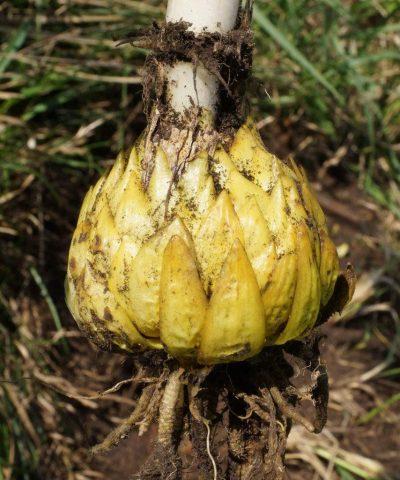
The bulb heads are prominent and fleshy
Where does the saranka lily grow?
Under natural conditions, the Saranka lily is found in deciduous forests on the European part of the mainland. Over the past decades, the plant has spread across the eastern half of the continent. Currently, wild specimens can be seen in Siberia, Transbaikalia, Altai and the Far East. Forest locust has quite large flowers and powerful, tall stems, which is clearly visible even in the photo. Buds can be either single or multiple. The petals of the wild lily are painted in bright, fiery shades.
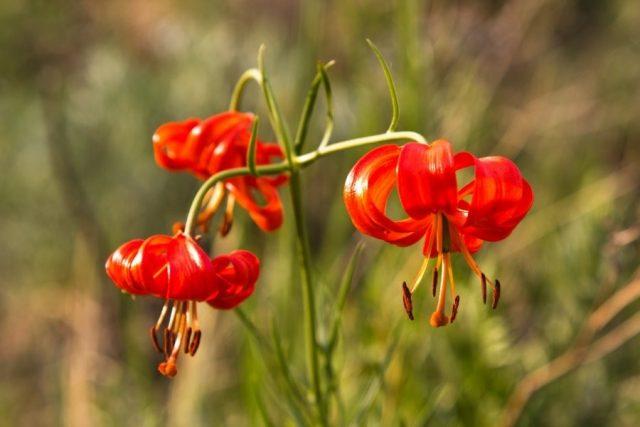
Wild locust grows for a long time, fallen seeds germinate next year, and flowering is observed after five years
Useful properties of forest locust
Martagon not only pleases the eye, its fruits are used in cooking. The bulb of the forest locust is considered edible. It is consumed raw, boiled and baked. Fresh onions are the basis for making seasonings, and dried, crushed onions replace flour.The product tastes like garlic. In addition, the heads of the saranka lily contain a whole complex of vitamins, valuable protein compounds, flavonoids, alkaloids, iron, and boron.
Martagon is widely used in folk medicine. The plant has a number of medicinal properties:
- tinctures are taken to relieve depression;
- squeezed juice relieves inflammation and accelerates tissue regeneration;
- A decoction of the petals relieves toothache.
In veterinary medicine, lily saranka is used as an additive in livestock feed. The substances contained in the bulbs improve lactation and increase the fat content of milk.
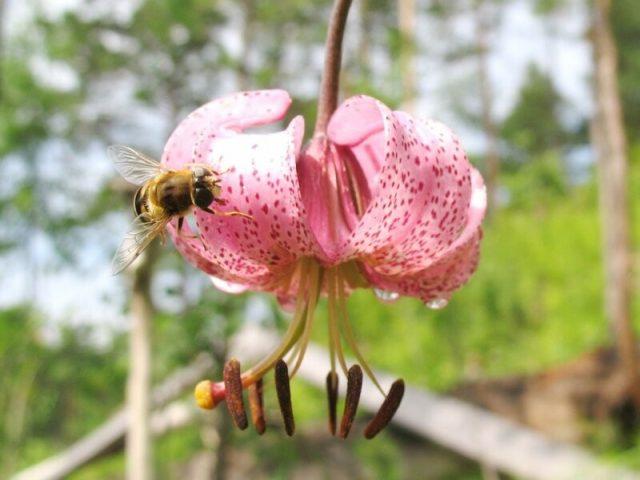
Thanks to the aroma and structural features of the flower, the curly lily is an excellent honey plant.
Types and varieties
Breeders have bred more than 200 varieties of Saranka lily. Some types of flowers are difficult to cultivate, so only some of them have become widespread.
Black Locust (Black Prince)
Black Prince is a variety of lily with dark burgundy, almost black buds. The plant blooms profusely in July.
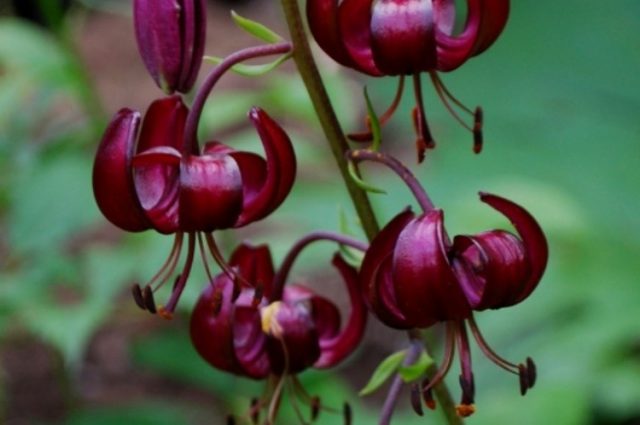
Black locust has dense, shiny petals with a reddish sheen at the edges
Guinea Gold
A crop with pale purple buds opening into yellow flowers with brown dots. The strong stem of the Golden Guinea is strewn with large lilies.
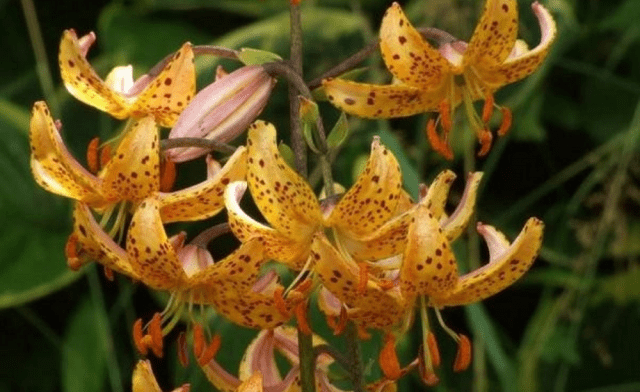
Lily Guinea Gold blooms late - in August and early September
Chameleon
Saranka curly Chameleon is distinguished by its voluminous buds. The color of the flowers is snow-white or bright orange.
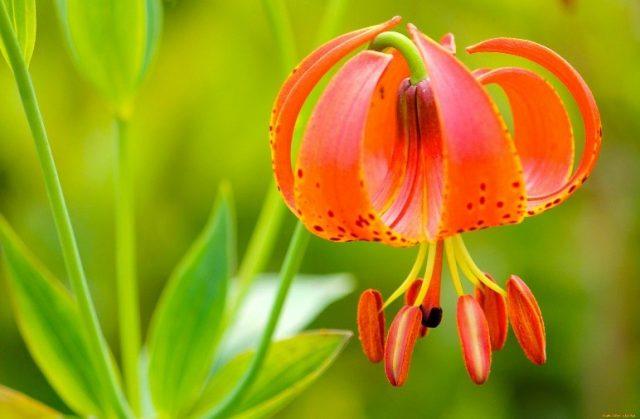
The Chameleon variety is especially popular among Russian gardeners
The choice of martagon lily varieties is extensive.In specialized stores you can select and purchase seeds of flowers that have attracted your attention.
Planting martagon lily
Many gardeners dream of having a beautiful plant in their flower garden. In those areas where Lily Saranka is found in natural conditions, wild bushes are dug up along with a clod of earth, trying not to damage the bulb and roots. If the procedure is carried out carefully, then the wild plant takes root well in the summer cottage.
Reproduction
In order not to cause damage to nature, it is advisable to use more conventional methods to spread the blooming culture. Several methods are used to propagate saranka lilies:
- planting bulbs;
- sowing seeds;
- rooting of bulbous scales;
- propagation by stems.
The last method is the most difficult. It is used by gardeners who have significant experience in cultivating flowers.
Agrotechnicians recommend planting saran bulbs from late August to mid-September. During this period the weather is still quite warm. In spring, bulbs are planted after the soil has thawed. A mixture of humus, peat and mineral fertilizer should be added to the ground. A light but slightly shaded area, sheltered from the wind, is suitable for growing lilies.

The soil in the flower garden should be loose, neutral or slightly alkaline, well drained
Curly lily seeds ripen in August. After collection, they are dried and kept in a cool place. Before winter or early spring, the seeds are sown to a depth of 2 cm. In the case of autumn planting, the area is mulched with humus. If sowing is carried out in the spring, then the seed material is prepared in advance: placed in a moist substrate (sand, peat or moss) and kept for 60 days at a temperature close to 0 0WITH.
At the end of winter, work on growing seedlings is organized. Martagon seeds are pre-treated with a disinfectant composition and planted in a container. The box is covered with film or glass. Keep crops in a room with a temperature of +16-190C. Young shoots of Saranka lily should be sprayed to prevent the seeds from being washed out of the soil during watering.
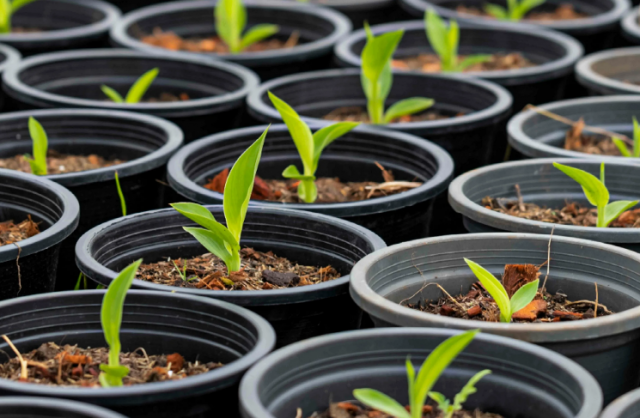
When foliage appears, the sprouts are planted, and with the beginning of summer they are transferred to open ground.
Saranka can be propagated by rooting bulb scales. To do this, in early August, the faded plant is dug up and the outer scales are carefully separated. After which the bulb is planted back, and the children are placed in a box with a soil mixture consisting of turf, sand and humus in a ratio of 2:1:1, sprinkled with a thin layer of peat on top, covered with film and placed in a shaded place. In September, bulbs with leaves form, which can be planted in open ground.
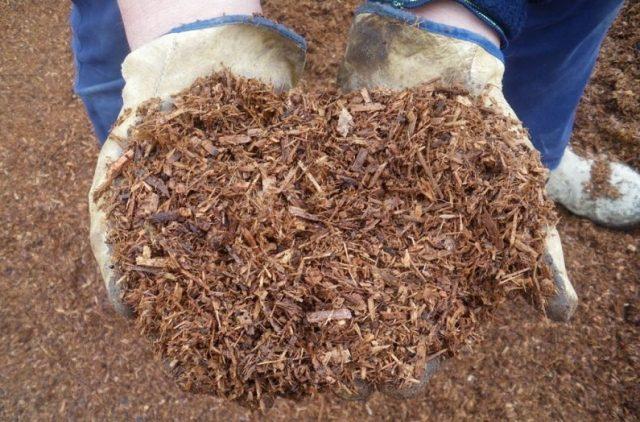
In winter, the area with martagon should be covered with a layer of hay or sawdust to protect it from the cold.
Caring for the martagon lily
Lily seedlings transferred to open ground require systematic care in the first year. Planting garden locusts requires:
- regular loosening of the soil;
- weeding as needed;
- moderate watering;
- sufficient lighting.
During the growing season, the saranka lily is fed several times. The fertilizer application regime is as follows:
- After the snow melts, nitrogen-containing compounds are used.
- During the formation of buds, the plant is fed with ammonium nitrate.
- In July, potassium-phosphorus complexes are added.
Throughout the summer season, the soil is mixed with wood ash.With its help, they improve the decorative qualities and increase the immunity of the plant. Methods for propagating saranka lilies and features of caring for the plant are presented in the video:
Martagon bushes that have adapted to a permanent location do not require special care. Further cultivation involves the implementation of usual agrotechnical procedures.
Saranka lily tolerates cold weather well, provided it is properly prepared for wintering. Some gardeners dig up the bulbs. In fact, it is permissible to leave the heads in the ground, but you must definitely cut off the dead stem, as in the photo, then next year Siberian locust flowers will appear earlier than with new planting of the bulbs.
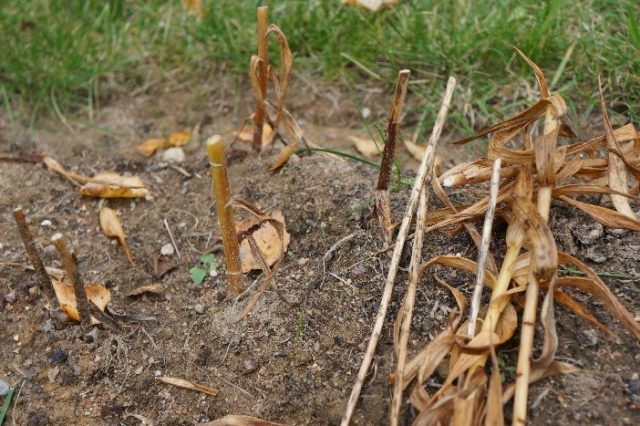
If in other types of lilies the above-ground part is completely removed for the winter, then in martagon the stem is only shortened
Diseases and pests
If the agrotechnical conditions for keeping the saranka lily are observed, the plant develops correctly and has good immunity. Heavy, prolonged rains in cold weather can cause infections.
Bacterial rot
The disease develops on young shoots of locust in the spring. Leaves and buds become stained, turn yellow, and fall off. Bacterial rot can affect lily bulbs, which become soft and foul-smelling. Control the disease with fungicides.
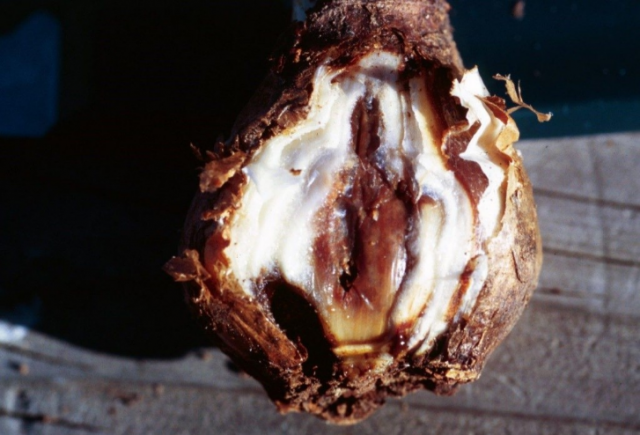
Martagon bulbs spoiled by bacterial rot should be destroyed.
Gray mold
Damage to the plant manifests itself in the form of yellow and brown spots, as well as drying out of the leaves. To prevent fungal infection, it is recommended to spray the leaves of the saranka with Fitosporin, Topaz or Skor twice a month.
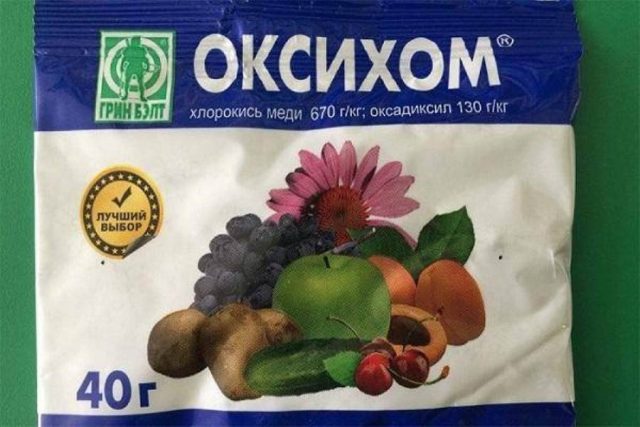
In autumn, the soil in the flower garden is treated with OXYCH or HOM to protect against gray mold.
Brown rot
Sometimes the locust is affected by a disease caused not by a fungus, but by bacteria. The infected bulb turns yellow and dries out, followed by the death of the above-ground part of the lily. For preventive purposes, planting material is treated with a fungicide.

Bacteria-affected areas of the saranka lily bush and bulb turn brown
The plant can be damaged by insects. The greatest damage to martagon is caused by the lily fly. The parasitic insect lays larvae in flower buds. Also, lily plantings can suffer from beetles, thrips, fall cutworms, aphids, spider mites and onion mites. Insecticides are used to control pests.
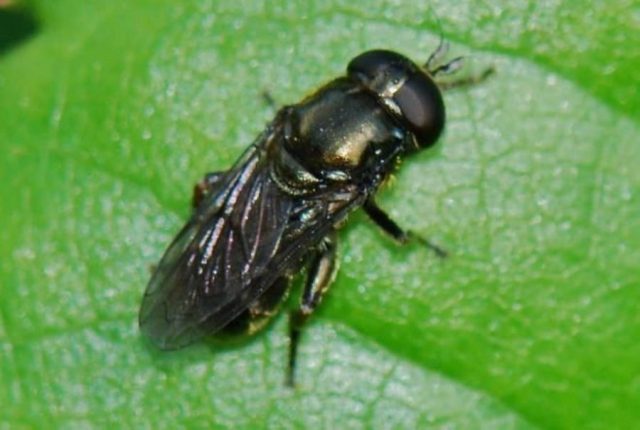
The larvae of the lily fly eat away the tissue of the lily flowers, causing the buds to lose their shape and die
Conclusion
Saranka lily is distinguished by its unpretentiousness, resistance to temperature changes and invulnerability to frost. The graceful plant looks great against the background of trees and shrubs, so martagon plantings can become a spectacular decoration of the territory of a country house, park or square.
